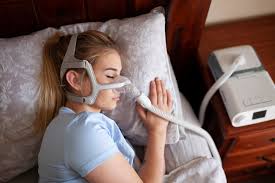
For many people with sleep apnea, a CPAP machine is a lifeline. It helps keep airways open, reduces apnea episodes, and supports more restful sleep. But sometimes, the very machine meant to restore your sleep may introduce CPAP disruption of its own. A machine that seems to “work” on paper can still leave you waking in fatigue, restlessness, or discomfort. Recognizing how your CPAP machine might be undermining restful sleep is key to getting the most from your therapy.
In this article, we’ll explore the subtle ways a CPAP machine can disrupt your rest — from mask leaks to pressure drift, noise, moisture, and user–machine mismatch.
Mask Leaks: Silent Saboteurs of Sleep
One of the most frequent causes of CPAP disruption is mask leaks. When pressurized air escapes around the mask seal instead of going into your airway, it not only reduces therapy efficacy but also causes audible hissing or micro-drafts that interrupt sleep. According to SleepApnea.org, mask leaks are among the top causes of CPAP side effects and user dissatisfaction.
Leaks may also cause dry eyes (if air escapes upward toward the eyes) or nasal irritation. Even minor leakage, over the course of a night, can shift your comfort and sleep architecture. The Mayo Clinic warns that frequent strap tightening to prevent leaks often signals an incorrect mask fit or style.
How to tackle leaks:
- Check mask fit while the machine is running — small adjustments can re-seal the cushion
- Replace worn cushions, frames, or headgear
- Try alternate mask styles (nasal, pillow, full-face) if one type consistently leaks
- Use mask liners or padding to improve the seal without overtightening
CPAP Machine Pressure Drift & Inconsistent Airflow
Your CPAP machine is calibrated to deliver a specified pressure to keep your airway open. But over time, settings may become less optimal as your body changes (weight fluctuations, nasal congestion, posture). If your prescribed pressure is no longer perfect, the machine may struggle to maintain stable airflow, causing micro fluctuations or oscillations that disturb your sleep.
Some devices adapt via algorithms or auto-adjusting modes, but these features also carry the risk of overshooting or “hunting” between pressures — again interrupting your rest. A machine that “chases” your airway response rather than holding a steady baseline can inadvertently introduce micro-arousals.
If you notice persistent restlessness despite using CPAP, it’s worth revisiting your settings or having your sleep provider review nightly pressure data.
Noise, Vibrations & Mechanical Whispers
Even modern CPAP machines are meant to be quiet, but mechanical fans, motor hum, tubing vibration, and internal resonances can introduce faint noise or whirring that disturbs light sleep or sleep onset. These noises may not fully wake you, but they can subtly degrade sleep quality.
Another issue is condensation noise (often called “rainout”) — moisture building inside the tubing, then dripping or bubbling during the night. This gurgling noise can jar micro awakenings. A clogged filter, loose parts, or worn bearings can amplify these sounds.
How to reduce mechanical noise:
- Place the machine on a soft, padded surface or vibration dampener
- Use a longer hose so the machine is farther from the head
- Ensure all components (filters, hoses, connectors) are secure and clean
- Replace aged machines or parts that hum, buzz, or rattle
- Use white noise or ambient sound as masking if tolerable
Humidifier & Moisture Imbalance
Many CPAP systems include heated humidifiers to combat dryness. But an improperly balanced humidification setup can either underdeliver moisture (resulting in dryness, nasal irritation) or overdeliver (leading to water collecting inside the tubing or mask). That condensation, when it drips or bubbles, can disrupt rest.
Also, too much humidity may make the mask cushion swell or misfit, altering seal and introducing leaks. If your CPAP machine’s humidifier settings are off, it might quietly be working against restful sleep.
Strategies:
- Fine-tune humidifier level (lower or raise in small increments)
- Use heated tubing to reduce temperature gradients and minimize “rainout”
- Drain or reposition tubing loops so water collects away from mask
- Clean humidifier chamber regularly to prevent microbial buildup
Discomfort, Skin Pressure & Subtle Irritation
A well-fitted mask should sit snugly but comfortably. However, daily contact, strap tension, or misalignment can produce pressure marks, skin irritation, or facial soreness. Over nights, these minor irritations can alter how you sleep (changing posture, mask adjustment, micro-arousals), affecting overall rest.
Some users shift subtly during sleep to avoid pressure spots, introducing mask movement and leaks. This cascade — discomfort leading to movement, leading to leaks — can fragment sleep without waking you fully.
Tips for comfort:
- Rotate mask types or cushions to shift pressure zones
- Use mask liners, gel pads, or softer cushions
- Replace skin-contact parts regularly
- Check strap tension — snug, not tight
- Monitor your skin nightly for emerging marks
Why These Disruptions Matter
Even though many of these disruptions may not fully awaken you, they can interfere with sleep architecture — the cycles of deep, REM, and light sleep your body depends on. Micro interruptions or leaks can prevent reaching or sustaining restorative phases.
Moreover, you may start associating CPAP time with frustration or discomfort, reducing adherence. Harvard Health notes that many users abandon CPAP because of mask issues, dryness, or discomfort — not because the therapy itself fails.
To get full health benefits — improved oxygenation, reduced cardiovascular risk, improved energy — your CPAP machine must not only treat apneas but support genuinely restful sleep nights after night.
What You Can Do Now
- Review machine data — monitor nightly leak rates, pressure deviations, and usage patterns
- Reevaluate mask fit — ideally with professional fitting or supervised adjustment
- Maintain your equipment — clean, replace filters, cushions, and hoses before performance degrades
- Adjust humidification carefully — fine-tune settings to match room conditions and avoid “rainout”
- Upgrade if necessary — newer machines often have quieter motors, better algorithms, and improved comfort features
- Seek expert help — your sleep provider or respiratory therapist can help interpret data and tweak settings
In conclusion, while your CPAP machine is intended to restore restful sleep, problems like mask leaks, pressure drift, mechanical noise, moisture imbalances, and skin discomfort can quietly work against that goal. Addressing these issues — through careful tuning, equipment maintenance, and provider support — helps ensure your machine becomes an ally, not a disruption, in achieving genuine nightly rest.
